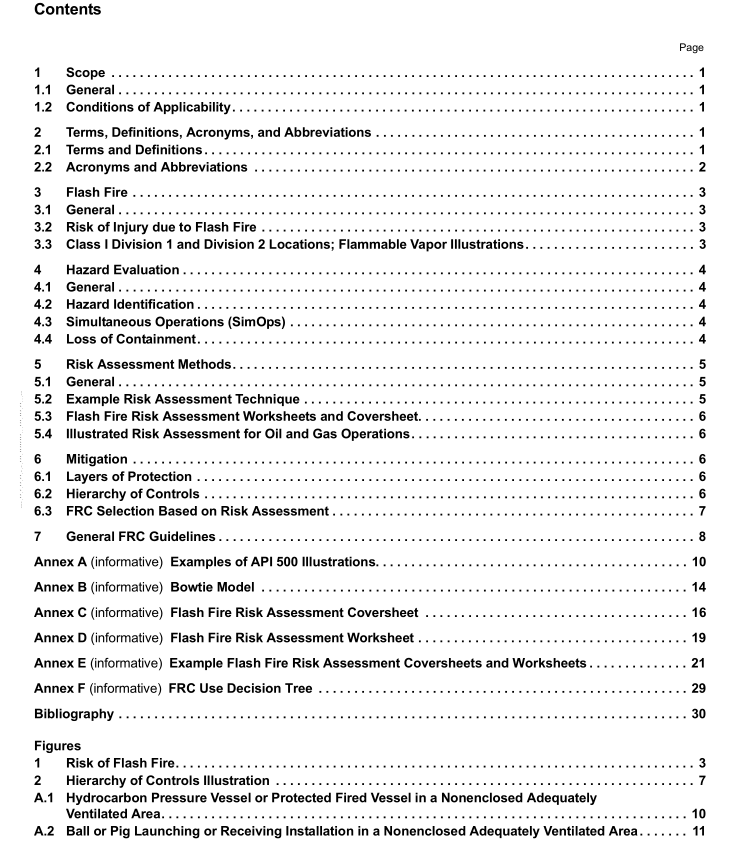API RP 99 pdf download

API RP 99 pdf download Flash Fire Risk Assessment for the Upstream Oil and Gas Industry
Conditions within a classified area may change, resulting in a change to the risk of flash fire. If hydrocarbons have not been introduced or have been removed, additional controls may not be needed. For example, if working on a purged and inert system or drilling through a zone that does not produce hydrocarbon vapors at the surface, no risk of flash fire would be expected. 4 Hazard Evaluation 4.1 General Where potential flash fire hazards exist, employers shall conduct a risk assessment and utilize controls to mitigate the risk of flash fire injury. See Section 6 (“Mitigation”) and Section 7 (“General FRC Guidelines”).
4.2 Hazard Identification This RP recognizes that hazard identification is done prior to risk assessment. The hazard assessment process should include an identification of fuel sources, ignition sources, and job tasks. Risk assessments may take many forms, such as those included in Section 5 and the annexes. These tools are provided as a resource, blending hazard identification steps with risk assessment and mitigation. These worksheets are not intended to replace existing safe work practices that have been implemented. Employers may rely on established methods to identify the risk of flash fire such as job hazard analysis, job safety analysis, or other risk assessment techniques.
4.3 Simultaneous Operations (SimOps) SimOps is a regular occurrence in the upstream Exploration and Production sector of the oil and gas industry and should be a consideration when determining the potential risk for flash fire. When SimOps occur, the operation with the highest flash fire risk level of all affected operations shall determine if FRC is utilized for the entire SimOps activity.
4.4 Loss of Containment The employer shall evaluate the risk of loss of containment. If personnel are performing a task that increases the probability of release of flammable materials, the employer shall take steps to mitigate the risk. As part of this risk assessment the employer shall consider the following questions.
a) Is the worker doing a task that increases the risk of loss of containment
b) Will the product released produce a flammable vapor
c) What controls are currently in place to minimize the risk of the flammable vapors to the air
d) What controls can be put in place to minimize the risk of a release? The concept of performing a flash fire risk assessment that evaluates the inherent risk of materials while considering the risk of loss of containment is consistent with established industry standards. Flammable gases (NFPA Hazard Level 4 as defined in NFPA 704) are usually vapors and are ignitable at normal temperatures if a process is open under normal atmospheric conditions. Flammable liquids (NFPA Hazard Level 3) are usually ignitable at normal temperatures if a process is open. Less hazardous (NFPA Hazard Rating 2 or 1) materials produce flammable vapors if heated above their flash point. If containment failure occurs with flammable gases, liquids or heated combustible liquids the worker is exposed to the risk of flash fire.
5 Risk Assessment Methods
5.1 General
Many methodologies are available to assess the risks associated with activities that pose a flash fire hazard.Using the appropriate methodology will promote a better understanding of the risk and the necessary mitigation measures. The employer is responsible for determining which assessment methodology best suits their needs.
Consideration should be given to various factors during a risk assessment including, but not limited to, the following:
a) proximity of the workers to the flash fire hazard;
b) potential for the task creating loss of containment (e.g. line breaking);
c) current operations (drilling, completions, production, construction, gas processing, etc.);
d) engineering controls to reduce the likelihood or consequences of flammable releases;
e) flash fire accident history;
f) means and duration of egress from the potential flash fire exposure zone;
g) multiple fuel sources;
h) chemical exposure;
i) SimOps.









